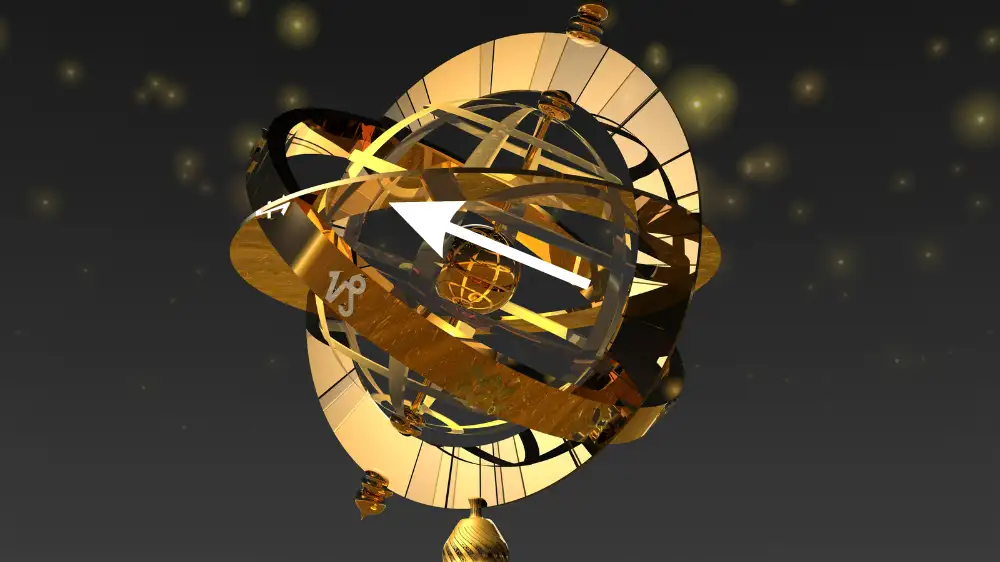A primary direction is a form of an applying spatial aspect (i.e., the angular distance between planets). The number of degrees in this aspect indicates the number of years from birth to the predicted event.
The technique of primary directions is one of the oldest forms of forecasting. It is mentioned in Ptolemy's Tetrabiblos in the section on predicting the duration of life.
This article is also available in video format:
[toc]
Mundane Aspect
Just as planets occasionally form exact angles of 60, 90, 120, and 180 degrees on the zodiacal circle, called zodiacal aspects, planets can also form spatial, i.e., mundane aspects on the celestial sphere. In essence, spacial aspects resemble exact aspects of horary astrology — when two planets meet each other in applying aspects, it measures the time of the event. However, there are fundamental differences.
Firstly, the planets perform spacial (or mundane) aspects in the first hours after birth. As the celestial sphere rotates during the first hours of life, the moving planets form new “chemical patterns,” which I believe shape the primary neural imprint at birth. From a celestial geometry perspective, this appears as the rotating celestial sphere overlaying its initial position at birth. In their daily (or primary) motion, the moving planets and their aspects approach the planets and house cusps from the natal chart.
Secondly, there is a fundamental difference in the interpretation:
- In horary astrology, an aspect is the collision of two specific objects: the event we observe. In natal astrology, the applying promittors (planets and their aspects) produce the event (the affairs of a particular house) relative to a specific area of life, shown by the second planet in aspect — the significator. See this article to get familiar with promittor and significator.
- In horary astrology, we evaluate the potential of the aspect based on the context of the situation, the motives of the two participants in the events (receptions), and their ability to act (accidental strengthening). In natal astrology, we look at the promittor's ability to create, destroy, or negate the house's affairs.
Spatial conjunction
First, we must understand the conjunction of two planets in the celestial sphere. A line from south to north through the significator is called the significator's horizon under its pole or its circle of position. If the significator is a house cusp, this line coincides with the dividing line between the houses.
Promittor is approaching significator's circle of position.
Next, we keep the significator's horizon stationary and allow the promittor (star, planet, its aspect, or antiscion) to reach that line. The promittor's path to the significator's stationary circle of position, in degrees, indicates the number of years from birth to the event.
Converse Directions
Sometimes, the path from the promittor to the significator's circle of position takes more than 180 degrees. In this case, astrologers sought ways to calculate the shortest route. Some ancient astrologers rotated the sphere in the opposite direction, allowing the promittor to reach the significator's horizon by the shortest path. We call such directions converse.
However, as Morinus pointed out, this calculation method contradicts common sense. The celestial sphere does not rotate in the opposite direction in the first hours after birth. We need to find a way to direct the rotating horoscope to the stationary radix figure to calculate the shortest distance between one planet and the circle of positions of the other.
For this purpose, he proposed a more straightforward method: leave the promittor and its circle of position stationary and move the significator along with the sphere until it reaches the promittor's horizon. If the significator is the house cusp, we direct its zodiac degree to the promittor's circle of position. This approach changes the length of arcs in converse directions and, in practice, confirms incredible accuracy.
However, Morinus, the most renowned scientist and professor of mathematics of his time, improved the primary directions even more, bringing them to the next level of accuracy.
Circle of Aspects
For a long time, astrologers disagreed on which plane to plot planets' aspects for primary directions. Some believed it should be the surface, parallel to the ecliptic, while others thought it should be parallel to the equator or prime vertical. The figure below shows the surface of aspects parallel to the ecliptic. Directions utilizing aspects in this plane are called zodiacal directions with the planet's latitude.
Planet (in the center) and its aspects on a surface, parallel to the ecliptic. Planet is slightly above the ecliptic at the moment.
Morinus brilliantly resolved this problem. He proposed constructing the plane of aspects, considering the apparent motion of planets (including their loops). He built a surface that passes through two points—the planet's current position and the point of maximum elevation above the ecliptic on the planetary path from the past to the next node. Thus, the plane of aspects depends on the planet and the current moment.
Planet (white dot) and its aspects on a surface, constructed by Morinus. Blue dots represent the places where the planet deviates most from the zodiac circle along its apparent motion path (blue dashed line).
The promittors (planetary aspects) plotted in this plane, approaching the significators, indicate the most accurate timing of events. You have already seen that the deviation between the direction indication and the event amounts to only a few months. At the same time, aspects of planets plotted in other planes give a difference of several years.
Antiscion on 3D Sphere
But Morinus's genius did not stop there. He also considered that planets' antiscia are not just a mirror reflection of the planet on the zodiacal circle but the intersection of the arc of its diurnal motion with the ecliptic surface. Therefore, on the three-dimensional sphere, planets have not one but two antiscia.
Planet (white dot) is slightly above the ecliptic, hence it has two antiscia.
These positions of the antiscia also provide a more accurate result. For example, in Hitler's chart, Venus rules the 8th house; it conjuncts Mars and Algol. Relative to Saturn in the 10th house, it indicates deadly threats or violent death from a head wound (according to Mars and Algol) due to the native's own actions. The far antiscion of this Venus (a Venus' copy, which fell in the middle of the 8th house of death) approached Saturn, indicating September 1945. Several month before that, in April 1945, Hitler shot himself in the head. So, you can see the accuracy of our results when we apply Morinus' calculations.
The Key of Direction
But that's not all Morinus left us. Astrologers have long noticed that the number of degrees the celestial sphere rotates corresponds to approximately, but not precisely, the number of years. Over the years, astrologers have tried to find a key that could accurately translate the degrees of directional arc into years of life so that they would closely match reality. One such key was suggested by the German scientist, professor of mathematics Valentin Naibod. He proposed taking one year of life not as 1 degree of the planet's diurnal path but the Sun's mean daily motion along the equator, which is 0°59'08” (or 0.9855°).
Morinus examined many keys, applying them to the plane of aspects he constructed. He found that Naibod's key gave the most accurate timing.
Since one year of life corresponds to 0.9855°, then 1 degree of the arc of direction corresponds to approximately 1.0147 years of life. The slightest error in the key would lead to a significant deviation in terms by age 50-60. But Naibod's key and Morinus's plane are devoid of this drawback—they accurately indicate the timing of events throughout the native's life.
Accuracy of timing in primary directions
Primary directions usually indicate not an exact date but a period of several months when the expected event may occur. Astrologers use secondary forecasting techniques to clarify the particular circumstances of the predicted event and its exact timing (down to the day). These secondary forecasting techniques include but are not limited to transits and revolutions, like solar returns.
Therefore, if you hear the phrase "solar return for the year," remember that it is not so much a prognostic as a clarifying technique - it is based on the secondary movement of planets. On the other hand, the primary direction is a primary forecasting technique since it is based on a more explicit and influential form of heavenly motion.
Suppose a solar chart promises you a year full of events, but the direction, as a more priority forecasting technique, prohibits significant events this year. In that case, your solar chart for the year will not give you anything. Therefore, be skeptical of yearly forecasts based solely on solar return (solar chart).
An Example of Directions in Action
I suggest looking at these resources:
- Princess Diana: death prediction by primary directions article. The Princess's chart is noteworthy in that dozens of contemporary astrologers could not find the time and circumstances of her death in it. But primary directions quickly solve this problem.
- Example of predicting children's birth with primary directions.
- Celestial State Assessment Example article. It has a section on primary directions.
- Example of predicting the exact date of marriage demonstrates the complete forecasting cycle, including primary directions
[promoFreeCourse]


